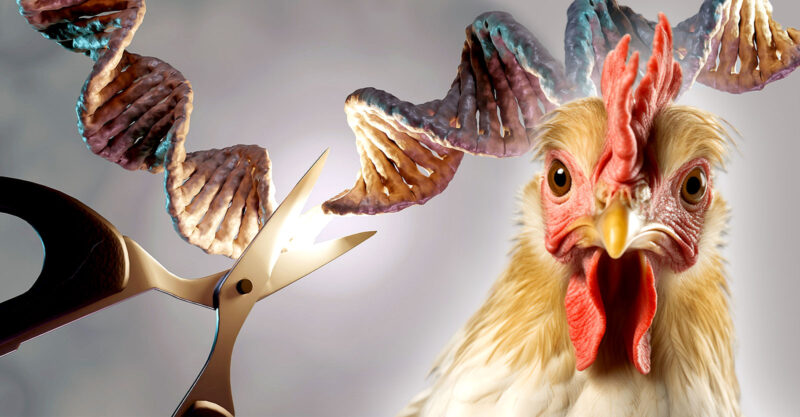Health Conditions
Scientists Used CRISPR Gene Editing to Make Chickens Resist Bird Flu — Here’s What Happened
U.K. researchers used the gene-editing technology CRISPR to alter chicken DNA to create birds resistant to deadly bird flu viruses like H5N1. But the study was a failure, according to one critic, because the technology also helped the virus replicate more efficiently in human cells.
Editor’s note: This article originally appeared in The Defender on Oct. 17, 2023. We are republishing it today as part of The Defender’s ongoing coverage of bird flu.
Scientists who used the gene-editing technology CRISPR to create chickens resistant to avian influenza also showed how quickly a dangerous bird flu could mutate from laboratory chickens to humans, critics of a new study in the journal Nature Communications told The Defender.
The authors of the study, led by researchers at Imperial College London and the University of Edinburgh Roslin Institute and Royal (Dick) School of Veterinary Studies, altered the genetic code of 10 chickens to make them resistant to a bird-flu virus and then exposed them to the virus.
They also included 10 chickens in the study that were not genetically altered. All 10 chickens not genetically altered got sick when they were exposed to the virus. Only one of the genetically altered chickens got sick with the bird flu.
Altering a species’ DNA “promises a new way to make permanent changes in the disease resistance of an animal,” University of Edinburgh embryologist Mike McGrew, Ph.D., an author of the study, said at an Oct. 5 news briefing announcing the peer-reviewed research.
“This can be passed down through all the gene-edited animals, to all the offspring.”
According to the study, “Chickens genetically resistant to avian influenza could prevent future outbreaks. … Breeding for resistance and resilience to disease has significant potential in farmed poultry,” freeing farmers from routinely having to vaccinate birds.
But Jonathan Latham, executive director of the Bioscience Resource Project, who has a master’s degree in crop genetics and a Ph.D. in virology, told The Defender,
“The experiments were ultimately a failure of ‘the operation was a success but the patient died’ variety.”
When the 10 genetically altered chickens were exposed to a much higher dose of bird flu — more in line with what the chickens could be exposed to in nature or a factory farm setting — five of the 10 chickens developed the flu.
Virus samples collected from the infected, genetically altered birds showed the virus had made several mutations that seemed to allow it to bind to the ANP32A protein to replicate in the chickens, the study reported.
The virus also mutated a workaround to bind to two other related proteins for replication.
Worse yet, according to Latham, mutations also helped the virus replicate more efficiently in human cells.
While viral mutations in human cells in vitro may not occur when the virus reaches a human being, the result was not encouraging, Latham said, adding that more efficient infection in human beings would be “likely.”
“The overarching concern about avian flu is not that chickens will die,” he said. “It is that large commercial flocks allow flu types acquired from wild birds to evolve in them, and those flu types then go on to infect and actually kill their human owners, farmworkers and potentially cause a pandemic.”
The authors of the Nature Communications study “caused a flu to evolve that, according to their test, was more infectious in human cells,” Latham said. “They thus created what they intended to prevent.”
CDC: Risk to humans ‘small’
Avian flu, or bird flu, is caused by viruses adapted to birds. A particularly lethal version of bird flu known as H5N1 has spread since 1996, with rapid global transmission in recent years, killing millions of wild and farm birds, infecting wild mammals like mink and bear, causing isolated human deaths, and wreaking economic havoc in the U.S. poultry industry and among American egg consumers.
The World Health Organization (WHO) said H5N1 outbreaks “have caused devastation in animal populations, including poultry, wild birds, and some mammals, and harmed farmers’ livelihoods and the food trade” and “pose ongoing risks to humans.”
By 2022, deadly H5N1 outbreaks in poultry and wild birds had occurred in 67 countries in five continents, with more than 131 million domestic poultry lost due to death or culling in affected farms and villages. Another 14 outbreaks were reported this year, mostly in the Americas.
By March, the largest bird flu outbreak in U.S. history had struck the American poultry industry, leading to the deaths of millions of chickens, higher egg prices, supply shortages and the Biden administration considering mass vaccination of poultry.
The virus infected wild birds and more than 58 million farmed chickens in 47 states, jumped to mammals like raccoons and bears, and could mutate and spread to humans, raising the “frightening specter of a human pandemic.”
Though H5N1 in humans can cause severe disease with a high mortality rate, the WHO said, only eight cases worldwide were reported from December 2021 to June 2023, with infection mostly linked to close contact with infected birds or contaminated environments.
The Centers for Disease Control and Prevention (CDC) said the risk to humans was small and the chances of a global pandemic were low.
In the past, bird flus have been responsible for some of the world’s deadliest pandemics, according to the CDC. In 1957, a new bird flu emerged in East Asia, triggering the “Asian flu” pandemic that killed an estimated 1.1 million people worldwide and 116,000 in the U.S. In 1968, a novel bird flu emerged from Hong Kong and caused the “Hong Kong flu” pandemic, with an estimated 1 million deaths worldwide and about 100,000 in the U.S.
The “Spanish” influenza H1N1 pandemic of 1918-1919 killed an estimated 50-100 million people worldwide, a widely accepted figure the CDC supports, though recent scholarship suggests the death toll, while major, was under 25 million. The “Spanish flu” virus was not isolated during 1918-1919, the CDC said, “but when the technology was available the genetic sequence was later determined to be an avian-like H1N1 virus.”
‘No such thing as an easy button for influenza’
Using the gene-editing tool CRISPR, the researchers were able to change the chickens’ DNA and alter the genetic code by targeting a specific chicken gene that makes the ANP32A protein, which the bird flu hijacks to replicate itself.
The goal was to make it impossible for the bird-flu virus to take over the ANP32A protein and make copies of itself, thus preventing the virus from replicating in the chickens.
The control group of 10 chickens that were not genetically altered and the gene-edited group of 10 chickens were both sprayed with a dose of bird flu virus into their nasal passages. The researchers used a milder dose than the deadly H5N1 virus spreading around the world.
When the researchers gave the gene-edited chickens, only one of which was infected with the first dose of the flu virus, the second, stronger dose of the virus — 1,000 times higher — five of the 10 were infected. But they had low viral loads and didn’t infect the other genetically altered chickens, researchers said.
The researchers also said that when they created chicken cells that lacked the ANP32A protein and the two other proteins that the virus mutated to attack, the virus was unable to replicate.
This result suggested to the researchers that their next step should be to create chickens genetically altered in all three genes of the protein family.
But Latham said knocking out all three genes would be impossible, as the study itself indicates.
“This combination of knockouts is expected to be deleterious to the animals’ health, but illustrates a proof of principle that multiple edits in host genes could be combined to confer sterile resistance.”
“If they eliminated all three genes, the chicken would be dead,” Latham said.
The researchers didn’t check to see if contaminating DNA from the CRISPR machinery remained in the chicken, a known risk of gene editing, he said.
Latham saw the study as unfortunately typical of science journals, edited down primarily to publish, with “things left out, artfully presented, flaws hidden.”
Carol Cardona, DVM, Ph.D., a professor in the University of Minnesota Department of Veterinary and Biomedical Sciences and an avian disease specialist, told The New York Times the study showed the difficulty of engineering animals against rapidly replicating and evolving influenza.
“There’s no such thing as an easy button for influenza,” she said.
Jaydee Hanson, policy director for the Center for Food Safety in Washington, D.C., told The Defender his organization was more concerned with vaccinating U.S. poultry against salmonella, which has mutated into deadlier forms and, according to the CDC, causes 1.35 million infections a year, with 26,500 hospitalizations and 420 deaths.
“We don’t (vaccinate chickens) for things that can kill people, but we do it for bird flu that kills birds,” Hanson said, “because that impacts the mega-chicken producers’ bottom line.”
“Genetic engineering for salmonella won’t work either,” Hanson said. “There are too many variables.”






No comments:
Post a Comment